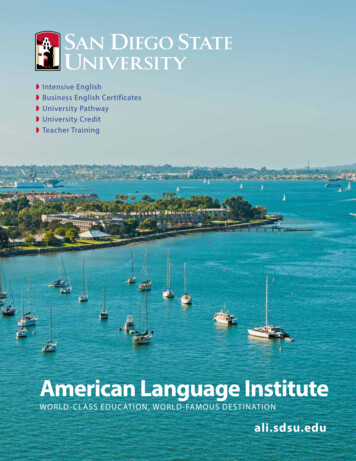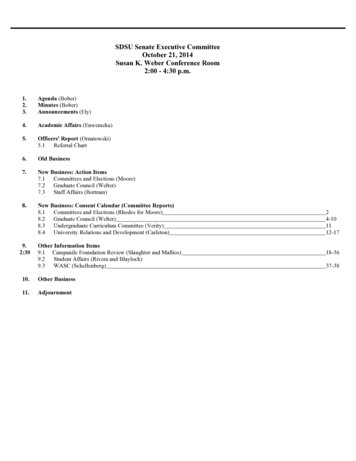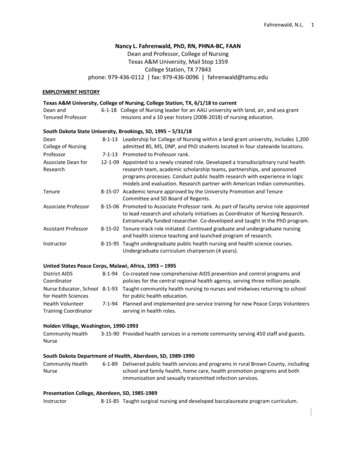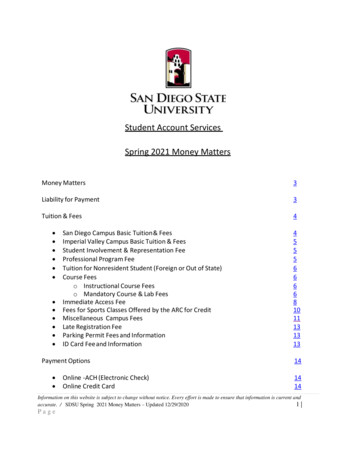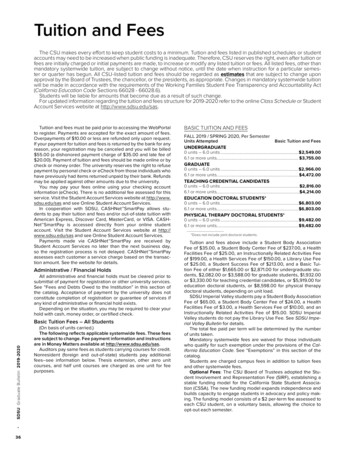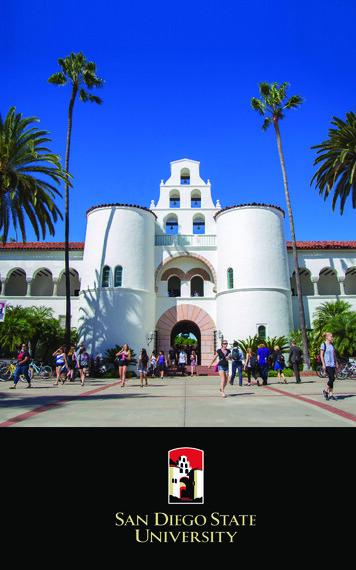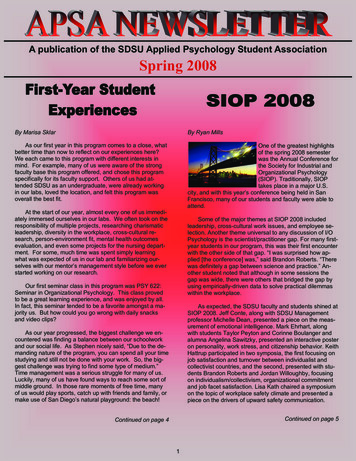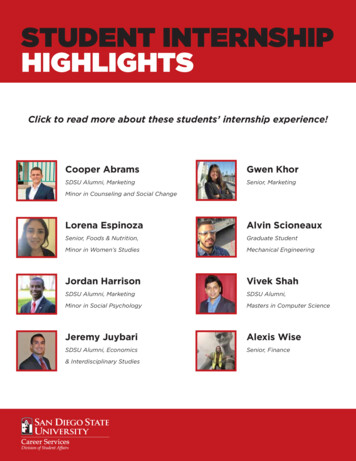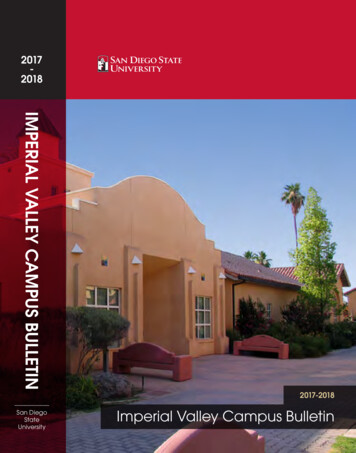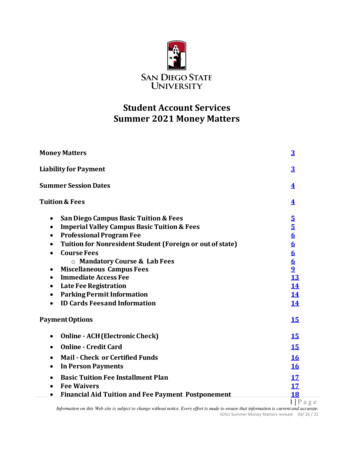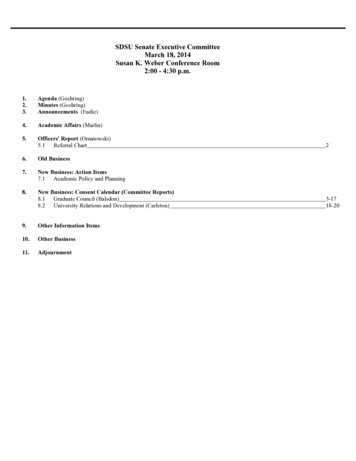
Transcription
SDSU Senate Executive CommitteeMarch 18, 2014Susan K. Weber Conference Room2:00 - 4:30 p.m.1.2.3.Agenda (Goehring)Minutes (Goehring)Announcements (Eadie)4.Academic Affairs (Marlin)5.Officers' Report (Ornatowski)5.1 Referral Chart6.Old Business7.New Business: Action Items7.1 Academic Policy and Planning8.New Business: Consent Calendar (Committee Reports)8.1 Graduate Council (Balsdon)8.2 University Relations and Development (Carleton)9.Other Information Items10.Other Business11.Adjournment23-1718-20
Date:To:From:Subject:March 18, 2014SECCezar Ornatowski, Vice Chair, SDSU SenateReferral Chart (Information)!CommitteeDateItemReferred byAcademicPolicy andPlanningOctober 9, 2013OfficersAcademicPolicy andPlanningOctober 9, 2013AcademicResources andPlanningOctober 9, 2013Provide a policy by which online andblended classes may be approved as newcourse proposals or as shifts of existingcourses to online or blended modes.Draft a policy specifying criteria forallowing pre-majors access to adepartment’s advanced courses prior toqualifying for major status.Review the budget decisions made overthe past few (3-6) years and assess howwell the budget shortfall was handled. !Provide recommendations for ways ofmoving forward from past practices.SEC March 18, 2014!OfficersOfficers– 2 – Referral Chart
To:SECFrom:The Graduate Curriculum CommitteeDate:March 3, 2014Re:2015-2016 Graduate BulletinINFORMATION (6I-03-14)DUAL LANGUAGE AND ENGLISH LEARNER EDUCATION (FORMERLY POLICYSTUDIES IN LANGUAGE AND CROSS-CULTURAL EDUCATION)1.Change in rubric.Dual Language and English Learner EducationDLE 600A. Foundations of Democratic Schooling (3)Prerequisite: Consent of instructor.Analysis of relationships among ideology, culture, and power in educationalcontext; key concepts in critical pedagogy applied to programs, curricula, and schoolrestructuring. (Formerly numbered Policy Studies in Language and Cross-CulturalEducation 600A.)Change: Abbreviation change from PLC to DLE.2.Change in rubric.Dual Language and English Learner EducationDLE 600B. Foundations of Dual Language Programming for Critical BiliteracyDevelopment (3)Prerequisite: Bilingual 2042 credential or score of 3 on SDSU Spanishexamination.Critical literacy and democratic schooling for dual language program models.Program models that apply to policies and practices that inform literacy curriculum andpedagogy in dual language-biliteracy settings. (Formerly numbered Policy Studies inLanguage and Cross-Cultural Education 600B.)Change: Abbreviation change from PLC to DLE.3.Change in rubric.Dual Language and English Learner EducationDLE 601. Language Policies and Practices (3)Prerequisite: Consent of instructor.SEC March 18, 2014– 3 – Graduate Council
Formal and informal policies related to education of linguistically diverse studentsat micro/macro level and in school contexts; analysis of bilingual and cross-culturalissues in cognition and literacy. (Formerly numbered Policy Studies in Language andCross-Cultural Education 601 and 653.)Change: Abbreviation change from PLC to DLE.4.Change in rubric.Dual Language and English Learner EducationDLE 603. Community and Schools in a Diverse Society (3)Prerequisite: Consent of instructor.Linguistic and cultural diversity of school and community. Development ofcommunity sociocultural scan; home and school collaboration; effects of home andschool collaboration on achievement; responsibility of parent caretaker, stakeholder forstudent success. (Formerly numbered Policy Studies in Language and Cross-CulturalEducation 603.)Change: Abbreviation change from PLC to DLE.5.Change in rubric.Dual Language and English Learner EducationDLE 604. Learning and Teaching Language in a Dual Language Setting (3)Prerequisite: Bilingual 2042 credential or score of 3 on SDSU Spanishexamination.Dual language instructional methods, modeling oral and written grammaticalstructures. Language acquisition strategies for English and Spanish in K-12 grades.Emphasis on written structures for academic literacy. (Formerly numbered Policy Studiesin Language and Cross-Cultural Education 604.)Change: Abbreviation change from PLC to DLE.6.Change in rubric.Dual Language and English Learner EducationDLE 650. Curriculum Development for Urban School Communities (3)Prerequisites: Dual Language and English Learner Education 600A and 601.Curriculum development through lens of critical theory. Principles of curriculumand instruction contextualized and with regard to particular educational institutions orwork sites from a social justice perspective. (Formerly numbered Policy Studies inLanguage and Cross-Cultural Education 650.)Change: Abbreviation change from PLC to DLE.SEC March 18, 2014– 4 – Graduate Council
7.Change in rubric.Dual Language and English Learner EducationDLE 651. Curriculum, Teaching, and Assessment: ELD and SDAIE (1-3)Prerequisite: Dual Language and English Learner Education 915A or 915B.English language development and delivery of comprehensive instruction forEnglish learners. Strategies for implementing state adopted instruction programs for ELDin language and content. (Formerly numbered Policy Studies in Language and CrossCultural Education 651.)Change: Abbreviation change from PLC to DLE.8.Change in rubric.Dual Language and English Learner EducationDLE 653. Language Development in K-12 Multilingual Classrooms (3)Prerequisite: Admission to bilingual authorization credential program.Dual language and multilingual classrooms, universals and differences inlanguage structure, transfer, and use (including basic linguistics). First and additionallanguage development; related factors (political/sociocultural aspects of bilingualism).Taught in English and Spanish. (Formerly numbered Policy Studies in Language andCross-Cultural Education 653 and 953.)Change: Abbreviation change from PLC to DLE.9.Change in rubric.Dual Language and English Learner EducationDLE 686. Seminar in Multicultural Education (1-6)Prerequisite: Consent of instructor.Topics dealing with current issues in multicultural education. See Class Schedulefor specific content. Maximum credit six units applicable to a master’s degree. (Formerlynumbered Policy Studies in Language and Cross-Cultural Education 686.)Change: Abbreviation change from PLC to DLE.10.Change in rubric.Dual Language and English Learner EducationDLE 798. Special Study (1-6) Cr/NC/RPPrerequisite: Consent of instructor; to be arranged with department chair andinstructor.Individual study. May involve fieldwork. Maximum credit six units applicable toa master’s degree. (Formerly numbered Policy Studies in Language and Cross-CulturalEducation 798.)SEC March 18, 2014– 5 – Graduate Council
Change: Abbreviation change from PLC to DLE.11.Change in rubric.Dual Language and English Learner EducationDLE 910. Teaching Mathematics to Bilingual Students (1-3)Prerequisite: Admission to Bilingual 2042 Multiple Subject credential program.Underlying learning theories for teaching mathematical concepts, computation,and problem-solving skills to bilingual students. (Formerly numbered Policy Studies inLanguage and Cross-Cultural Education 910.)Change: Abbreviation change from PLC to DLE.12.Change in rubric.Dual Language and English Learner EducationDLE 911. Teaching Social Studies to Bilingual Students (1-3)Prerequisite: Admission to Bilingual 2042 Multiple Subject credential program.Conceptual approaches for teaching bilingual social studies curriculum,incorporating sociocultural characteristics of multicultural community, social concepts,and community social issues. (Formerly numbered Policy Studies in Language andCross-Cultural Education 911.)Change: Abbreviation change from PLC to DLE.13.Change in rubric.Dual Language and English Learner EducationDLE 912. Teaching Science to Bilingual Students (1-3)Prerequisite: Admission to Bilingual 2042 Multiple Subject credential program.Strategies for development of process skills and concept acquisition.Methodology for teaching activity-oriented science class bilingually, (Formerlynumbered Policy Studies in Language and Cross-Cultural Education 912.)Change: Abbreviation change from PLC to DLE.14.Change in rubric.Dual Language and English Learner EducationDLE 915. Teaching and Learning in the Content Area: English LanguageDevelopment/SDAIE (1-3)Prerequisites: Education 451, Dual Language and English Learner Education 515,and admission to Bilingual 2042 Single Subject credential program.SEC March 18, 2014– 6 – Graduate Council
Teaching strategies in content specific fields from second language acquisitionperspective taken concurrently with student teaching. See Class Schedule for specificcontent. May be repeated with new content. (Formerly numbered Policy Studies inLanguage and Cross-Cultural Education 915.)A. Multiple SubjectsB. Single SubjectsC. Special EducationChange: Abbreviation change from PLC to DLE.15.Change in rubric.Dual Language and English Learner EducationDLE 931. Skills in Teaching Reading to Bilingual Elementary Students (1-3)Prerequisite: Admission to Bilingual 2042 Multiple Subject credential program.Teaching reading in English, including methods, strategies, assessment, materials,and techniques of transition for implementing reading programs in the bilingualclassroom. (Formerly numbered Policy Studies in Language and Cross-CulturalEducation 931.)Change: Abbreviation change from PLC to DLE.16.Change in rubric.Dual Language and English Learner EducationDLE 933. Skills in Teaching Reading to Bilingual Secondary Students (3)Prerequisites: Upper division standing. Admission to Bilingual 2042 SingleSubject credential program.Methods for developing reading skills in Spanish and English across subjectareas. Includes comprehension, academic vocabulary, concept development, readingstrategies, and assessment. Taught in Spanish and/or English. (Formerly numbered PolicyStudies in Language and Cross-Cultural Education 933.)Change: Abbreviation change from PLC to DLE.17.Change in rubric.Dual Language and English Learner EducationDLE 954. Classroom Organization for Democratic Teaching in Bilingual Classrooms(1-4)Prerequisites: Dual Language and English Learner Education 400; concurrentregistration in Dual Language and English Learner Education 524 and 963; admission tosingle subject bilingual 2042 program.Teaching practices to include democratic processes for classroom management inbilingual classrooms. Classroom teaching, classroom discipline, and curriculumSEC March 18, 2014– 7 – Graduate Council
management. Social-cultural and political contexts of teaching to include overview ofteacher performance assessment tasks. (Formerly numbered Policy Studies in Languageand Cross-Cultural Education 954.)Change: Abbreviation change from PLC to DLE.18.Change in rubric.Dual Language and English Learner EducationDLE 960. Professional Seminar for Bilingual Teacher Candidates (1-4) Cr/NCPrerequisite: Dual Language and English Learner Education 954.Lesson planning and organization for bilingual elementary and secondary teachercandidates. Meeting needs of diverse learners in biliteracy settings. Maximum crediteight units. (Formerly numbered Policy Studies in Language and Cross-CulturalEducation 960.)Change: Abbreviation change from PLC to DLE.19.Change in rubric.Dual Language and English Learner EducationDLE 961. Practicum in Elementary Bilingual Classroom (1-12) Cr/NCPrerequisites: Admission to Bilingual 2042 Multiple Subject credential program.Student must provide own transportation to student teaching site.Field experience at two grade levels in a multicultural setting and a bilingualelementary classroom; student teacher assumes responsibility for planning and instructionfor specified time to comply with State requirements. Maximum credit 12 units.(Formerly numbered Policy Studies in Language and Cross-Cultural Education 961.)Change: Abbreviation change from PLC to DLE.20.Change in rubric.Dual Language and English Learner EducationDLE 962. Student Teaching for Elementary Bilingual Students II (1-12) Cr/NCPrerequisite: Dual Language and English Learner Education 961.Field experience in a multicultural setting or a bilingual elementary classroom.Maximum credit 12 units. (Formerly numbered Policy Studies in Language and CrossCultural Education 962.)Change: Abbreviation change from PLC to DLE.21.Change in rubric.Dual Language and English Learner EducationSEC March 18, 2014– 8 – Graduate Council
DLE 963. Practicum in Secondary Bilingual Classroom (3-4) Cr/NCPrerequisites: Dual Language and English Learner Education 400; concurrentregistration in Dual Language and English Learner Education 524 and 954; admission tothe single subject bilingual emphasis program. Students must provide own transportationto student teaching site.On-site, part-time experience to implement bilingual teacher competenciesintroduced in Policy Studies in Language and Cross-Cultural Education 515, 524, and954. (Formerly numbered Policy Studies in Language and Cross-Cultural Education 963.)Change: Abbreviation change from PLC to DLE.22.Change in rubric.Dual Language and English Learner EducationDLE 964. Student Teaching for Bilingual Secondary Students II (8-12) Cr/NCPrerequisites: Dual Language and English Learner Education 524 and 963.Students must provide own transportation to student teaching site.On-site, full-day experience in State approved bilingual and nonbilingual classesto implement teacher competencies as developed in the total professional sequence.Maximum credit 12 units. (Formerly numbered Policy Studies in Language and CrossCultural Education 964.)Change: Abbreviation change from PLC to DLE.JOURNALISM AND MEDIA STUDIES1.Change in program.Journalism and Media StudiesSpecialization in Mass Communication and Media Studies(Major Code: 06010) (SIMS Code: 664141)(no change)Graduate Courses. Students may select Plan A, thesis, by completing Journalismand Media Studies 799A (3 units) or, if Plan B is selected, the student must completethree additional units of 600-700 level coursework in the School of Journalism and MediaStudies and pass the Comprehensive Examination in journalism and media studies. Theremaining 27 units of the program must include completion of Journalism and MediaStudies 600A and 600B with an average grade of B or better in the two courses, orconsent of the Journalism and Media Studies faculty; 12 units selected from Journalismand Media Studies 506, 527, 529, 547, 550, 560, 566, 567, 574, 581, 585, 587, 589, 590,591, 595, 596, 620, 696, 701, 710, 775, 780, 785, 798, and nine units relevant to thespecialization selected with the approval of the graduate adviser. No more than nine unitsmay be taken outside the School of Journalism and Media Studies. No more than six unitsmay be taken as special study (798). No more than 12 units taken at the 500-level maycount toward the degree.SEC March 18, 2014– 9 – Graduate Council
Change: Addition of new courses, Journalism and Media Studies 527, 547, 566, 567, 587to core course listing.LEARNING DESIGN AND TECHNOLOGY1.New course.Learning Design and TechnologyMOBILE APPS FOR LEARNING (C-4)LDT 630. Mobile Applications for Learning (3)Two lectures and two hours of activity.Prerequisites: Learning Design and Technology 540 and 541 or consent ofinstructor.Mobile learning models and examples. Design principles and developmentprocesses. Adapting mobile learning for different environments, settings, and cultures.Future trends.SEC March 18, 2014– 10 – Graduate Council
To:SECFrom:The Graduate Curriculum CommitteeDate:March 3, 2014Re:2014-2015 Graduate BulletinINFORMATION (6I-03-14.500)ART1.Change in title.ArtWORK ENVR INTERIOR DESIGNART 552. Work Environment Interior Design (3)Six hours.Prerequisites: Art 453 and completion of portfolio requirement. Proof ofcompletion of prerequisites required: Copy of transcript.Projects in architectural interiors involving the use and perception of enclosedspaces. Space planning systems analysis. Maximum credit six units.Change: Updated title from Interior Design IV.2.Change in title.ArtCOMMERC INTERIOR DESIGNART 553. Commercial Interior Design (3)Six hours.Prerequisite: Art 552. Proof of completion of prerequisite required: Copy oftranscript.Projects in interiors involving space planning analysis, specification writing,materials selection and furnishing design appropriate to commercial needs. Maximumcredit six units.Change: Updated title from Interior Design V.SEC March 18, 2014– 11 – Graduate Council
To:SECFrom:The Graduate Curriculum CommitteeDate:March 3, 2014Re:2015-2016 Graduate BulletinINFORMATION (6I-03-14.500)DUAL LANGUAGE AND ENGLISH LEARNER EDUCATION (FORMERLY POLICYSTUDIES IN LANGUAGE AND CROSS-CULTURAL EDUCATION)1.Change in rubric.Dual Language and English Learner EducationDLE 515. Multilingual Education: Theory and Practice for Biliteracy Teachers (3)Pedagogical and programmatic practices for addressing linguistic and academicneeds of multilingual learners. Historical and theoretical foundations of bilingualeducation as related to bilingual and dual language programs to include instruction,curriculum, and assessment. Taught in Spanish and English. (Formerly numbered PolicyStudies in Language and Cross-Cultural Education 515.)Change: Abbreviation change from PLC to DLE.2.Change in rubric.Dual Language and English Learner EducationDLE 523. Psychological Foundations for Biliteracy Teachers in K-6 Classrooms (3)Major theories of learning and cognition as applied to bilingual students and theirrelation to child development, first and second language acquisition, and approaches toteaching in bilingual classroom. (Formerly numbered Policy Studies in Language andCross-Cultural Education 523 and 923.)Change: Abbreviation change from PLC to DLE.3.Change in rubric.Dual Language and English Learner EducationDLE 524. Psychological Foundations for Biliteracy Teachers in Grades 7-12 (1-4)Bilingual learning theory as it affects adolescent growth, individualizedinstruction, classroom management and discipline, and methods of measuring andevaluating achievement. Taught in Spanish and English. May be repeated with newcontent. See Class Schedule for specific content. Maximum credit four units. (Formerlynumbered Policy Studies in Language and Cross-Cultural Education 524 and 924.)SEC March 18, 2014– 12 – Graduate Council
Change: Abbreviation change from PLC to DLE.4.Change in rubric.Dual Language and English Learner EducationDLE 532. Biliteracy Teaching in Language Arts for Elementary Students (3)Prerequisites: Dual Language and English Learner Education 415 and 515.Assessing language proficiency; selecting, designing, and evaluating learningexperiences to develop biliteracy in K-6 classrooms in English language arts and Spanish,Arabic, Filipino, Japanese, or Mandarin. Taught bilingually in language of emphasis andEnglish. (Formerly numbered Policy Studies in Language and Cross-Cultural Education532 and 932.)Change: Abbreviation change from PLC to DLE.5.Change in rubric.Dual Language and English Learner EducationDLE 553. Language Assessment and Evaluation in Multicultural Settings (3)Theories and methods of assessment and evaluation of diverse student populationsincluding authentic and traditional models. Procedures for identification, placement, andmonitoring of linguistically diverse students. Theories, models, and methods for programevaluation, achievement, and decision making. (Formerly numbered Policy Studies inLanguage and Cross-Cultural Education 553.)Change: Abbreviation change from PLC to DLE.6.Change in rubric.Dual Language and English Learner EducationDLE 596. Special Topics in Bilingual and Multicultural Education (1-3)Prerequisite: Consent of instructor.Selected topics in bilingual, cross-cultural education and policy studies. May berepeated with new content. See Class Schedule for specific content. Credit for 596 and696 applicable to a master’s degree with approval of the graduate adviser.Change: Abbreviation change from PLC to DLE.JOURNALISM AND MEDIA STUDIES1.New course.Journalism and Media StudiesADV TOPICS JOURNALISM (C-4)SEC March 18, 2014– 13 – Graduate Council
JMS 527. Advanced Topics in Journalism (3)Prerequisites: Journalism and Media Studies 300 with a grade of C (2.0) or better.Admission to journalism major.Reading, investigation, and research in a specialized topic in journalism. May berepeated with new content. Maximum credit six units.2.Change in prerequisite and title.Journalism and Media StudiesDATA-DRIVEN INV JOURNALISJMS 529. Data-driven Investigative Journalism (3)One lecture and four hours of activity.Prerequisite: Journalism and Media Studies 420 with a grade of C (2.0) or better.Proof of completion of prerequisite required: Copy of transcript.History and role of investigative journalism in the U.S. Use of the Internet, publicrecords, spreadsheets, and databases to develop stories in the public interest. Findingpatterns and leads in electronic data. Field and laboratory experience.Change: Deletion of Journalism and Media Studies 300, 310W; addition of 420.3.New course.Journalism and Media StudiesADV TOPICS MEDIA STUDIES (C-4)JMS 547. Advanced Topics in Media Studies (3)Prerequisites: Journalism and Media Studies 408 with a grade of C (2.0) or better.Admission to media studies emphasis, Major Code: 15060.Reading, investigation, and research in a specialized topic in media studies. Maybe repeated with new content. Maximum credit six units.4.Change in prerequisite.Journalism and Media StudiesJMS 550. Multimedia News Laboratory (3)One lecture and four hours of activity.Prerequisites: Journalism and Media Studies 420, 430 with grades of C (2.0) orbetter in each course. Proof of completion of prerequisites required: Copy oftranscript.Capstone course using skills and knowledge acquired in critical thinking, writing,reporting, editing, production, and design courses. Teams prepare multimedia newscontent. Field and laboratory experience. Completion of course with grade of C or betteris required for majors and minors.Change: Deletion of Journalism and Media Studies 300, 310W, 315, and 445.SEC March 18, 2014– 14 – Graduate Council
5.New course.Journalism and Media StudiesAD STRAT & DIGITAL ANYLTS (C-5)JMS 566. Advertising Strategy and Digital Analytics Platforms (3)Prerequisites: Journalism and Media Studies 460 or 480, and Journalism andMedia Studies 560 or 581, or consent of instructor.Strategy creation, implementation, and evaluation using digital analyticsplatforms. Digital analytics administration, monitoring, analysis, and reporting.Application of digital analytics to consumer advertising optimization.6.New course.Journalism and Media StudiesADV TOPICS ADVERTISING (C-4)JMS 567. Advanced Topics in Advertising (3)Prerequisites: Journalism and Media Studies 460 with a grade of C (2.0) or better.Admission to advertising emphasis, Major Code: 06041.Reading, investigation, and research in a specialized topic in advertising. May berepeated with new content. Maximum credit six units.5.New course.Journalism and Media StudiesADV TOPICS PUBLIC RELATNS (C-4)JMS 587. Advanced Topics in Public Relations (3)Prerequisites: Journalism and Media Studies 480 with a grade of C (2.0) or better.Admission to public relations emphasis, Major Code: 05992.Reading, investigation, and research in a specialized topic in public relations. Maybe repeated with new content. Maximum credit six units.SPEECH, LANGUAGE, AND HEARING SCIENCES1.Change in prerequisite.Speech, Language, and Hearing SciencesSLHS 512. Phonological Acquisition and Disorders (3)Prerequisite: Speech, Language, and Hearing Sciences 320 with a grade of C (2.0)or better. Proof of completion of prerequisite required: Copy of transcript.Phonology, phonological development, and phonological disorders as they relateto basic linguistic theory. Concepts considered through critical thinking and problemsolving.Change: Addition of grade C or better and proof of prerequisite statements.SEC March 18, 2014– 15 – Graduate Council
TELEVISION, FILM AND NEW MEDIA1.Addition of prerequisite.Television, Film and New MediaTFM 530. Selected Topics in Genre Studies for Television and Film (3)Prerequisites: Television, Film and New Media 160, 310, and 330. Open only totelevision, film and new media majors in upper division standing.Film and television genres (noir, western, comedy, musical, science fiction, soapopera, etc.) including key media texts, aesthetics, themes, history, and social context.May be repeated with new course content. See Class Schedule for specific content.Maximum credit six units.Change: Addition of prerequisites; none were listed prior.2.Change in prerequisite.Television, Film and New MediaTFM 550. Art Direction for Television and Film (3)One lecture and four hours of activity.Prerequisites: Television, Film and New Media 350; 361 or 362 for television,film and new media majors, and Theatre 440 for theatre majors, and consent of instructor.Proof of completion of prerequisites required: Copy of transcript.Aesthetic, technical, and practical aspects of design for television and film.Experience in scenic design, graphics, set decoration, budgeting, and scheduling.Change: Updates prerequisite to reflect Television, Film and New Media 360renumbering to 362.3.Change in prerequisite.Television, Film and New MediaTFM 560. Advanced Film (3)Two lectures and more than three hours of activity.Prerequisites: Television, Film and New Media 314 (or consent of instructor),361, and 362.Practicum in direction and production of dramatic and nondramatic film.Cameras, lighting, design, sound techniques, experience in university sponsoredproductions. Completion of a short film.Change: Updates prerequisite to reflect Television, Film and New Media 360renumbering to 362.4.Change in prerequisite.SEC March 18, 2014– 16 – Graduate Council
Television, Film and New MediaTFM 571. Selected Topics in Director Studies (3)Prerequisite: Television, Film and New Media 160, 310, and 330. Open only totelevision, film and new media majors in upper division standing.Historical significance of and theoretical approaches to major media directors(Welles, Hitchcock, Spielberg, etc.) including breadth of work, cultural and genericcontexts, aesthetic innovation, and recurring themes. May be repeated with new content.See Class Schedule for specific topic. Maximum credit six units.Change: Addition of Television, Film and New Media 160 and 330.5.Change in prerequisite.Television, Film and New MediaTFM 573. Selected Topics in History of Film, TV, and Media (3)Prerequisite: Television, Film and New Media 160, 310, and 330. Open only totelevision, film and new media majors in upper division standing.Media history including cultural and generic developments, patterns of exhibition,technological influences, significant creative and industrial figures, commercial andsocial contexts. May be repeated with new content. See Class Schedule for specific topic.Maximum credit six units.Change: Addition of Television, Film and New Media 160 and 330.SEC March 18, 2014– 17 – Graduate Council
Date:March 11, 2014To:SECFrom:Mary Ruth Carleton, VP University Relations and DevelopmentSubject: InformationThe Campaign for SDSU:The Campaign for SDSU has reached a new milestone. Our Campaign total is now at 477 million toward the goal of 500 million. Two significant gifts to The Campaign wererecognized on February 21st with the dedication of the J. Keith Behner and Catherine M. StiefelAuditorium and Charles Hostler Hall in the renovated Storm/Nasatir Hall.On March 7, SDSU recognized another significant gift to The Campaign with a ribboncutting event for the Lee and Frank Goldberg Courtyard. The Goldberg Courtyard is in theConrad Prebys Aztec Student Union which was also dedicated on March 7th and whichrecognizes a 20 million gift to SDSU from philanthropist Conrad Prebys.Other gifts of note to The Campaign are:Campanile Foundation Board Member and Alumnus Andy Esparza and his wife Karen,(also an alum) are gifting 50,000 to SDSU to support the College of Business HumanResources Program.Alumna Danah Fayman has made a gift of 104,000 for an endowment for SpecialInternships in the Arts.Alumnus Kenneth Kellett and his wife Darlene have committed to supporting theCollege of Business Administration through a bequest of 300,000.Campanile Board Member and Alumnus Michael Pack and his wife and fellow AlumnaChris have pledged 22,000 to support the Pack International Business Scholars and theInternational Business Programs Fund.Diane Gaske has established the Paul Gaske Memorial Scholarship Endowment inForensics with a pledge of 25,000.SEC March 18, 2014– 18 – University Relations and Development
The Love Library has received several gifts in kind: 435,351 from Ed Marsh, books andmaterials for the Ed Marsh Special Collections; 108,100 from Camille AbbottGurevitch, books and materials for Special Collections.Alumnus Gilbert Harrison has made two gifts totaling just under 100,000. These giftswill support an endowed scholarship for veterans and an endowed scholarship for nursingstudents.Campanile Foundation Board Member and Alumna Susan Salka is making a gift of 100,000 to support our Guardian Scholars Program.We have received yet another pledge toward the Confucius Institute in the College ofArts and Letters. This pledge is for 2 million to support programs in the Institute.Alumnus Anthony Ghio has committed to supporting our Athletic Program through abequest of 100,000.The College of Sciences has received a gift in kind of equipment from Illumina, Inc. Thegift is valued at 130,000.Longtime supporter and community leader Malin Burnham has made a gift of 30,000 tosupport the Basketball Performance Center Project.Alumni Engagement:We have launched a new, more user friendly on-living giving web 3/index.aspx?sid 997&gid 1&pgid 3034This is a critical step as we build our infrastructur
DLE 604. Learning and Teaching Language in a Dual Language Setting (3) Prerequisite: Bilingual 2042 credential or score of 3 on SDSU Spanish examination. Dual language instructional methods, modeling oral and written grammatical structures. Language acquisition strategies for English and Spanish in K-12 grades.
